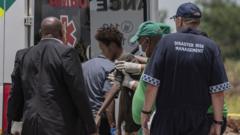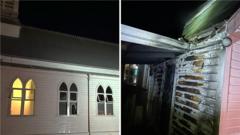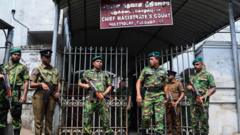Following a major rescue operation at a derelict South African gold mine, police are struggling to identify the 78 bodies retrieved, mostly believed to be undocumented migrants. Authorities face criticism over the rising death toll amid ongoing illegal mining activities fueled by gang control.
South African Police Face Daunting Challenge in Identifying Miners from Disused Shaft

South African Police Face Daunting Challenge in Identifying Miners from Disused Shaft
Police spokesperson warns that identification of deceased miners will be a "mammoth task" after over 240 illegal miners were rescued, with many undocumented.
In a recent operation at a disused gold mine in Stilfontein, South Africa, authorities recovered 78 corpses alongside over 240 illegal miners, escalating concerns over the ongoing issue of illicit mining in the region. Police spokesperson Brig. Athlenda Mathe described the identification of the deceased as a "mammoth task," noting that most bodies have been severely decomposed and many of the miners were undocumented migrants.
For months, these miners had been trapped underground, with authorities clamping down on food and water supplies since November to combat illegal activities. Although many miners managed to surface, the majority came from neighboring countries like Mozambique and Zimbabwe. The conditions faced by those rescued were dire; many exhibited signs of starvation and dehydration after prolonged periods without sustenance.
The situation has drawn sharp criticism from rights activists and trade unions, who accuse the government of negligence for the escalating death toll linked to criminal mining operations. Protesters confronted police and mines ministers during a site visit, blaming the administration for the fatalities.
Despite rescuing over 1,500 miners before operations intensified, fears of arrest kept others underground. Criminal gangs remain active in the abandoned mines, often selling precious materials on the black market.
As the rescued miners receive medical care, authorities are preparing to charge them with crimes related to illegal mining and immigration violations. Mines Minister Gwede Mantashe emphasized the economic threat posed by such illicit activities, asserting that this crackdown is essential to restore order to the sector. With unemployment surpassing 30% in South Africa, many former miners have turned to illegal activities as a last resort for survival, highlighting the complex interplay of desperation and crime in the region.
For months, these miners had been trapped underground, with authorities clamping down on food and water supplies since November to combat illegal activities. Although many miners managed to surface, the majority came from neighboring countries like Mozambique and Zimbabwe. The conditions faced by those rescued were dire; many exhibited signs of starvation and dehydration after prolonged periods without sustenance.
The situation has drawn sharp criticism from rights activists and trade unions, who accuse the government of negligence for the escalating death toll linked to criminal mining operations. Protesters confronted police and mines ministers during a site visit, blaming the administration for the fatalities.
Despite rescuing over 1,500 miners before operations intensified, fears of arrest kept others underground. Criminal gangs remain active in the abandoned mines, often selling precious materials on the black market.
As the rescued miners receive medical care, authorities are preparing to charge them with crimes related to illegal mining and immigration violations. Mines Minister Gwede Mantashe emphasized the economic threat posed by such illicit activities, asserting that this crackdown is essential to restore order to the sector. With unemployment surpassing 30% in South Africa, many former miners have turned to illegal activities as a last resort for survival, highlighting the complex interplay of desperation and crime in the region.



















